TA-Area
THIS SPACE IS WHERE TECHNICAL ADVISORS FIND ALL THE RELEVANT INFORMATION FOR THEIR ASSIGNMENTS.
THIS SPACE IS WHERE TECHNICAL ADVISORS FIND ALL THE RELEVANT INFORMATION FOR THEIR ASSIGNMENTS.
Resource Mobilisation is described as an organisation’s efforts to attract resources. Mobilising resources is a crucial component of project delivery and impact – it ensures that projects can be implemented and an organisation can achieve its vision. Instead of “fundraising”, the term “resource mobilisation” has gained popularity. “Resource” not only refers to financial funds, but can also include technical assistance / cooperation, human resources, physical goods and free services and facilities.
Resource mobilisation includes building and managing relationships with resource providers (donors) through communication as well as building and managing staff skills and knowledge and developing organisational capacity for resource management.
For organisations, structured and efficient resource mobilisation ensures the
continuation of your organisation’s service provision to beneficiaries. It not only supports organisational sustainability but also allows for improvement and scale-up of programmes, services and products.
If done properly resource mobilisation will allow you to…
Rather than focusing all your energy towards soliciting large amounts from big
funders, it is recommended that you focus on creating a diverse mix of funding
sources, including individual donors, corporations and international organisations.
You can determine your own, unique “funding mix”. This will help you spread the risk when a funder falls short or ends the engagement. It is also easier to start out with smaller funds from a donor.
They might be ready to increase their contribution once they have gained trust. Support may come in the form of large or small gifts, can be unrestricted, can be one-time donations, or can lead to long-term funding. There is also value in professionalising existing earned income activities to the point where they can significantly impact an organisation’s financial viability. However, you need to keep in mind that it takes resources (time, skills, money) to allocate and manage resources.
There are different sources of funding such as grants, gifts (e.g., from individuals or corporates) and earned income from the sales of goods and services. The characteristics of each are found in the table below:
Characteristics:
Examples:
Characteristics:
Examples:
Characteristics:
Examples:
Characteristics:
Examples:
Source: Venture for Fundraising (2010). Resource mobilisation. Available at
https://www.idrc.ca/sites/default/files/sp/Documents%20EN/Donor-Partnership-guide.pdf, accessed 7/10/2020.
Every project or activity your organisation plans requires resources. Resource
mobilisation can be broken down into three main phases:
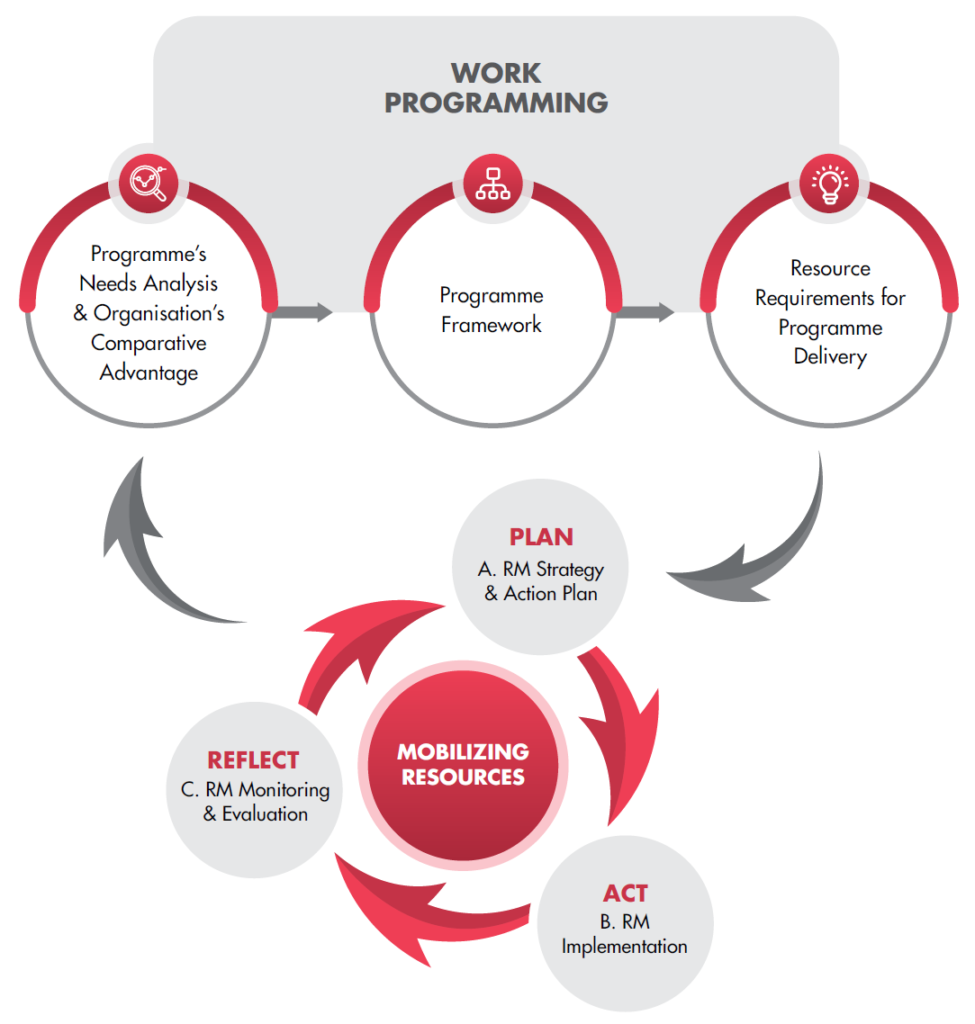
Source: FAO (2012). A guide to resource mobilisation.
Online at http://www.fao.org/3/i2699e/i2699e00.pdf, accessed 7/10/2020.
The planning phase starts with a situation analysis of your organisation and the external resource environment. This helps you to discover what resource mobilisation opportunities may exist and how best to approach potential resource partners. As a next step you can analyse the resource requirements of the programme or project and develop a plan on how to engage the likely resource partners. Finally, develop a resource mobilisation strategy and action plan describing how particular resource partners will be targeted and for which resources.
The implementation process depends on the resource mobilisation strategies youdeveloped in the planning phase (grants, gifts, or goods and services). You may have identified various channels and target audiences and different strategies will be applied to effectively mobilise resources from them. Rank the strategies according to highest expected return on investment, quick wins, and prioritise your implementation actions accordingly.
Last but not least, the resource mobilisation effort, including strategy and action plan, is monitored and evaluated. For this, it is important to develop sound monitoring and evaluating indicators as part of strategy development. Plan for a reflection phase and use the opportunity to reflect on and learn from your experiences. When systematically reflected successes and failures can yield valuable lessons learnt that will help you improve on your efforts in the next cycle. Click here for more information on experience capitalisation.
Resource mobilisation is effective when you connect with your resource partners and build relationships centred on shared values, trust and loyalty. The donor cultivation cycle shows a five-step process to cultivate resource partners: 1) Identification 2) Qualification 3) Cultivation 4) Solicitation and 5) Stewardship
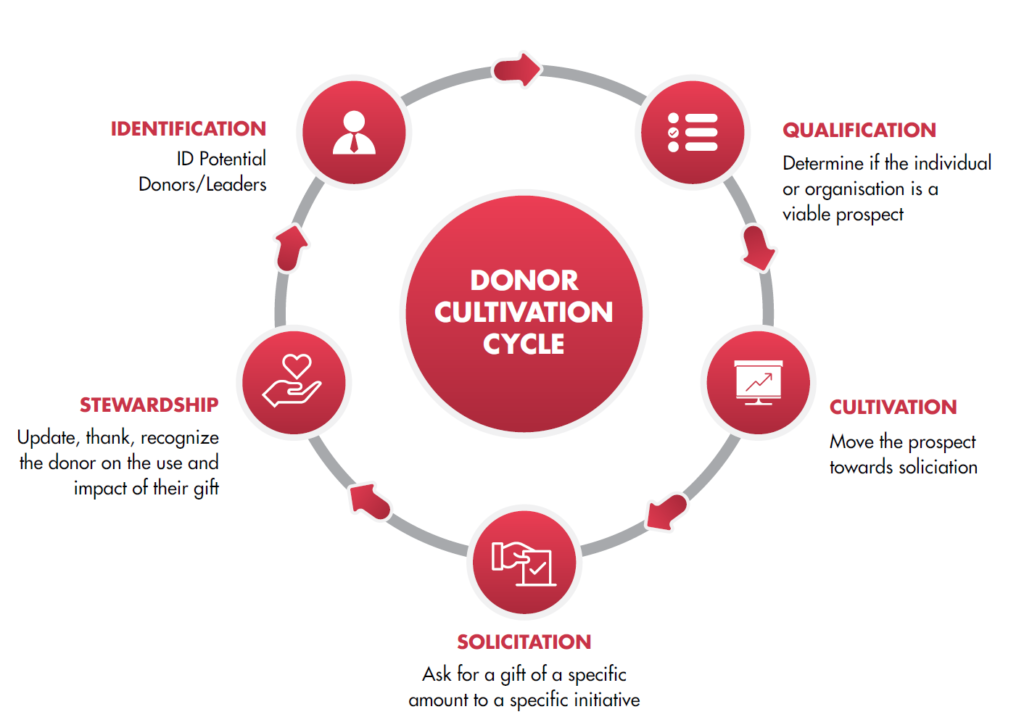
Source: Newman Consulting (2017). The Five Phases of the Donor Cultivation Cycle. https://newmanconsulting.ca/2017/09/the-5-phases-of-the-donor-cultivation-cycle/ accessed 7/10/2020.
The first step in the cycle is to identify donors by compiling a list of former, current and prospective resource partners. You can start this exercise by looking into your current and prior resource partner lists. It is important to note that identifying resource partners is an ongoing process. It requires continuous updating of the details of potential resource partners, also called prospects.
In the second step of qualification, you can map your resource partners’ interests (thematic and geographical) and verify if the resource partner is an acceptable source. Prospect research can be conducted through websites and publications by and about the resource partner and screening for organisations previously funded by the resource partner.
The cultivation phase can take between six to twelve months. The goal of this step is to find out your resource partner’s passion, motivation and goals for philanthropy and then offer the donor a variety of engagement opportunities. This step involves seizing every opportunity to build strong relationships with decision makers by establishing and maintaining open and regular dialogue with partners to build mutual trust and respect. Activities in this phase could be: resource partner meetings, development of advocacy tools, writing proposals, concept notes, developing other communication tools, delivering presentations to resource partners, and fostering individual contacts.The solicitation phase is the phase where you actually ask for a donation by the resource partner, negotiate to reach an agreement on joint interests, agree on the conditions of the partnership, including procedures on use of resources, and develop and formulate a legal agreement.
Last but not least, the stewardship phase sets the foundation for an ongoing cooperation with your resource partner. After a received donation, it is your responsibility to not only manage the channeling of funds, but also monitoring and reporting. This includes an acknowledgement of your partner’s contribution and a detailed report on how the funds were being used. Make sure to put sufficient effort into this step through consistent and sound communication. A communications plan and quality communication materials are important here.
“Resource mobilisation is a management process that involves identifying people who share the same values as your organisation, and taking steps to manage that relationship.” (IDRC 2010)
This definition depicts resource mobilisation as a threefold process,
involving Organisational Management and Development, Communicating and
Prospecting as well as Relationship Building.
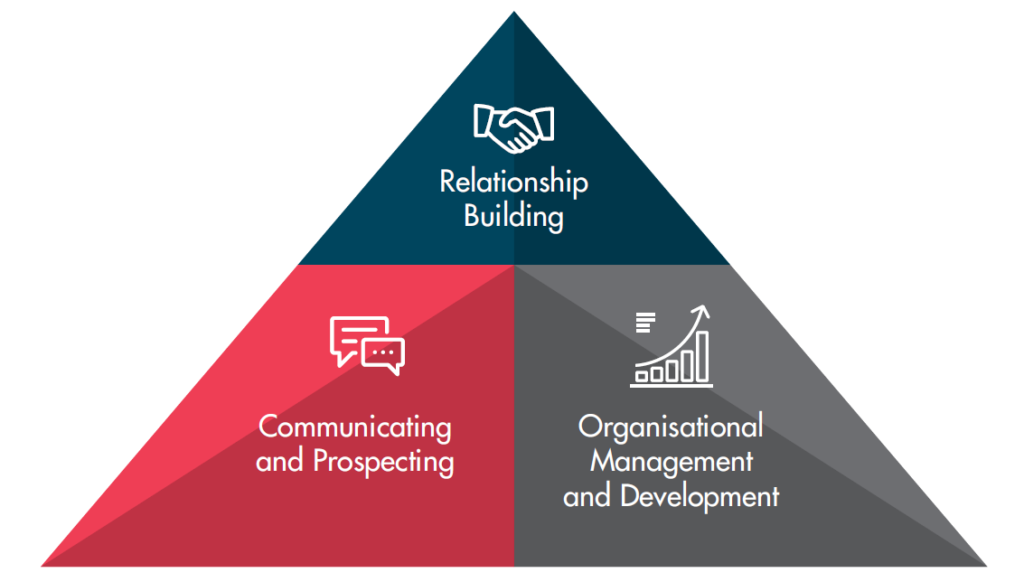
Source: JotForm (2020). Revenue Streams for Nonprofits. Available at
https://www.jotform.com/help/485-chapter-11-revenue-streams-for-nonprofits, accessed 23/08/2021.
Organisational management and development involve establishing and strengthening your organisation. Ultimately, also the resource mobilisation process will benefit from this. This involves identifying your organisation’s vision, mission, and goals, and putting in place internal systems and processes that enable resource mobilisation efforts. They include identifying the roles of board and staff in the process as well as effectively and efficiently managing human, material, and financial resources. Creating and implementing a strategic plan that addresses proper stewardship and use of existing funds is as important as continually seeking out diversified sources of future funding.
While organisational management and development set the foundation for successful resource mobilisation, communicating and prospecting ensure its long-term sustainability through acquiring new resource partners and maintaining a stable resource partner base. As previously mentioned, resource mobilisation is to a large extent connecting to resource partners in a relatable manner and exploring shared values and interests. This also includes identifying the right resource partners and to approach them with tools and messages that meet their interest. Your organisation should keep in mind that financial support is a direct result of a relationship built between people.
Once you have identified potential resource partners, the objective is to get closer to them and to get to know them better. The closer the relationship gets, the higher your chances of receiving higher levels of support which might go beyond financial support to increased interest and active involvement. This in
turn will help you to expand your network and relationships. Only organisations that succeed in building the most individual and sustainable relationships with their resource partners will be successful in resource
mobilisation. This is a great opportunity for smaller organisations, which usually have a more personal relationship with their donors. Of course, this requires the dedication of your board members, management, staff and volunteers.
The key elements of relationship building are consistent communication, strong connection to your cause and trust building. Awareness and trust can only be built through sustainable communication. Experience has shown that dialogue is more successful than monologue. For resource mobilisation to be successful, your organisation must succeed in building a trust relationship with your resource partners through dialogue.
In this context, internationally renowned fundraising consultant Ken Burnett (1992) speaks of “relationship fundraising“:
“Relationship fundraising is an approach to the marketing of a cause which centers not around raising money but on developing to its full potential the unique and special relationship that exists between a charity and its supporters. Whatever strategies and techniques are employed to boost funds, the overriding consideration in relationship fundraising is to care for and develop that special bond and not to do anything that might damage or jeopardize it. In relationship fundraising every activity of the organisation is therefore geared towards making donors feel important, valued and considered. In this way relationship fundraising will ensure more funds per donor in the long term.” (Burnett, K. 1992. Relationship Fundraising – A Donor Based Approach to the Business of Money Raising. White Lion Publishing: London, p.59.)
Another important aspect of relationship building is to connect all resource mobilisation efforts to the cause, the why of your work. Your cause influences your target audience, you would like to choose partners who are also passionate about what you want to change and who will support your work with all their heart. Therefore, it is important to collect information on the interest and areas of funding of donor potentials. Then, filter them in your analysis according to their interest in the why of your organisation. Your cause and impact influence the stories you tell about your work and the way you interact with the donors. Following the type of organisation that you are, be it advocacy or service delivery, or humanitarian, your communication strategy and angle may differ. As a consequence, the messages in your donor care, interactions and in the asks, are framed to reflect your why and in turn the interests of your audience. The organisational focus and attitude define not only what you ask for, but also how you ask. They will be unique to your organisation and help you build a relationship with an audience with a specific interest in your areas of work and the contribution you make to a greater change.
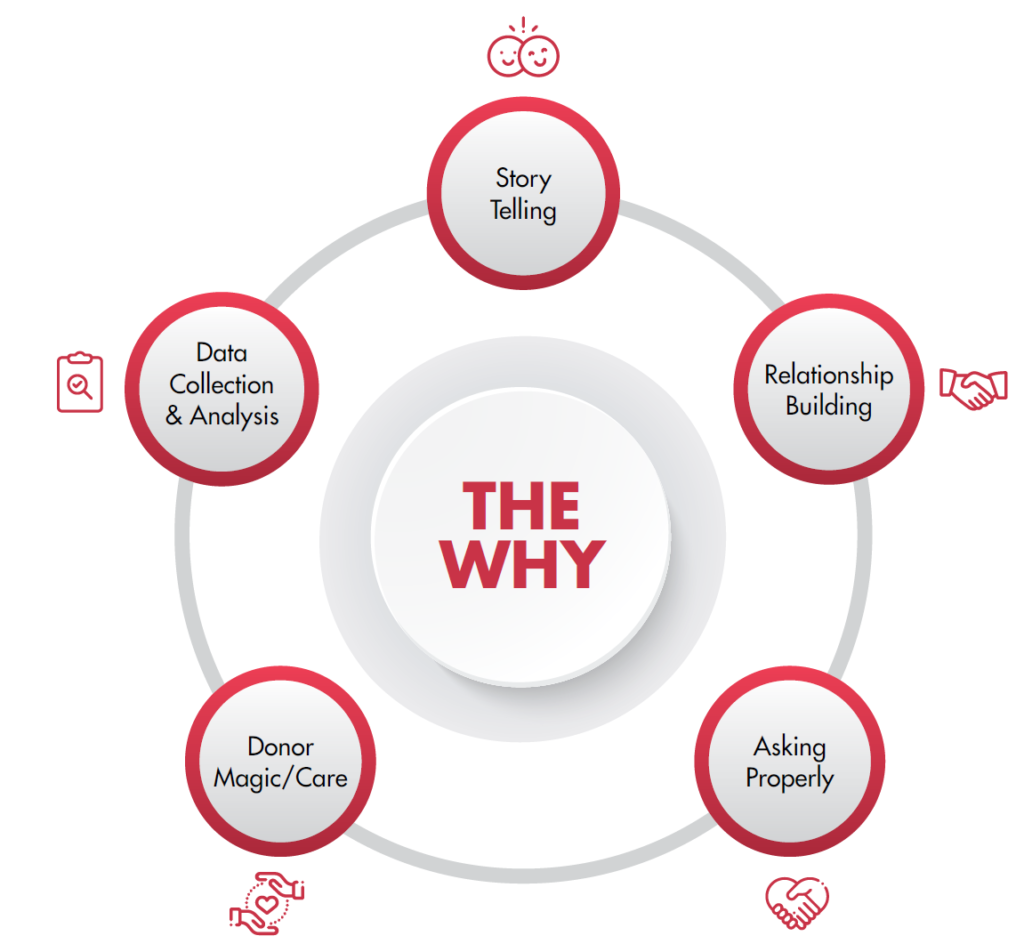
Source: Craig Linton & Paul Stein (2016). Donors for Life: a practioner’s guide to relationship fundraising. Available at http://blogs.plymouth.ac.uk/criticalfundraising/wp-content/uploads/sites/37/2016/02/DFL-Craigs-chart..png, accessed 7/10/2020.
Relationship building aims to build a long-term relationship between your organisation and its resource partners. The better and longer the relationship, the greater the resource partner‘s confidence in ‘their’ organisation; the greater the willingness to take on more (financial) responsibility for the organisation step by step. This gradual process of relationship fundraising can be illustrated using the model of the donor pyramid (Urselmann, M. 2019: Fundraising: Professionelle Mittelbeschaffung für gemeinwohlorientierte Organisationen. Springer: Cologne, p. 102).
At the bottom of the pyramid are interested individuals and organisations. Those can be individuals who subscribed to your mailing list, or have voiced any other form of interest.
An entry-level strategy like a special event or a mail campaign are ideal to bind individuals to your organisation and raise their interest further. The key is to provide resource partners with successive giving opportunities that may increase their commitment and interest in the organisation so that they move to the next level. It is important to note that not all resource partners move to the next level.
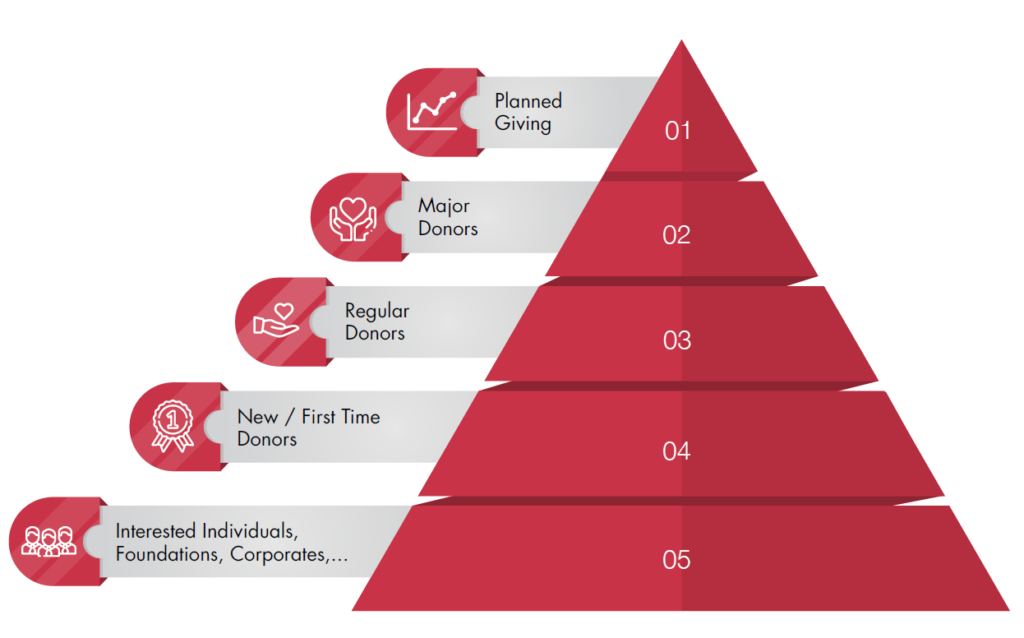
The donor pyramid should encourage you to consider which strategies are appropriate for each level. The principle applies that you only get what you ask for. Ideally, there is a separate marketing concept for each level of the donor pyramid. It specifies in detail how to communicate with a donor at the respective level and what specific offers should be made to him to climb the next higher level.